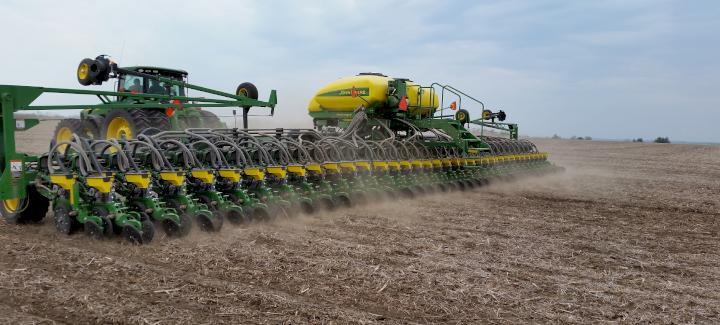
For many corn and soybean growers, the end of planting season is near. The USDA’s National Agricultural Statistics Service’s (NASS) weekly crop progress report for May 21 states that 81% of corn and 66% of soybean acres are planted. Of corn planted, 52% has emerged. The 2023 corn planting progress is 12% ahead of last year at this time and 6% ahead of the five-year average (2018–2022). Of soybeans planted, 36% have emerged. Soybean planting progress is 19% ahead of last year at this time and 14% ahead of the five-year average.
Crop progress in Stine’s regions
Last week we reported crop progress from Stine® Regions 4, 5, 12, 13, 20 and 27, which encompass states like Texas, Iowa, Missouri, Kansas, Illinois and Nebraska. Here are the latest updates from some of our other regions throughout the country.
Aaron Stockton, Region 9 RSA (southeast Kansas, southwest Missouri and northwest Arkansas)
Planting season has been great here in Region 9. We are essentially done with corn planting and have a good start on soybeans. Corn is at the V3–V6 stage and looking good in most areas. Most soybeans look great as well. It has been several years since we have had this much ground covered and crops looking this good. Wheat harvest should start in a month or so, and then double crop soybean season will be underway. Looking forward to a great season!
Kevin Ryan, Region 14 RSA (Arkansas, Mississippi, Louisiana and Tennessee)
All corn is planted; it’s from V8 to tasseling. We started out early, and it’s been a very smooth planting season. We had a few rains but had spells where we could plant for a week straight. Corn looks great! Everybody has added fertilizer to it. Weather is cooler than normal, and it’s growing fast. We are 80% to 90% done with soybeans, and quite a few fields have emerged. This has been a very good year; we’ve had the least amount of replant that I can remember. All rice is planted. Growers are now focused on planting cotton. All in all, it’s been as good a planting season as I can remember. We’re way ahead of normal. If we can beat the heat this summer, and it looks like we will, we should have a great crop.
Paige Harris, Region 15 RSA (northeast Wisconsin, Michigan, New York)
Region 15 is about 75% planted for both corn and soybeans. There was some early planting due to good weather early on. But with a cool, wet spring, some producers got a late start. Even with the cool conditions, we are seeing great emergence from the Stine Enlist E3® soybeans and MX Series Corn. With this stretch of nice, dry weather, most should be able to finish planting soon. This spring is setting up to have excellent conditions for the whole state of Michigan.
Katie Lorenz, Region 21 RSA (northern and eastern North Dakota, western Minnesota)
North Dakota is taking full advantage of their open window with suitable planting conditions. Dust is in the air as equipment is going nonstop to get the 2023 crop in while still maintaining adequate topsoil and subsoil moisture. Corn is 40% planted, ahead of last year at only 20%, but behind the five-year average of 50%. Soybeans are 25% planted throughout the state, ahead of last year’s 10%. If hard rain holds off, we will successfully get the crop in and see emergence early next week. Early GDUs with light pockets of rain could set this year up for record yields with Stine Seed!
What is the USDA Crop Progress Report?
The USDA NASS crop progress report is released every week throughout the busy planting, growing and harvest seasons. The report tracks crop progress by state and includes the 18 states that planted 92% of the corn acreage and 95% of the soybean acreage in 2022. The USDA NASS crop progress report features current week-ending results, the year prior results, and the five-year average for planting, emergence and crop conditions for primary crops throughout the U.S., including corn, soybeans, cotton, sorghum, rice, peanuts, sugar beets, sunflowers, wheat and more.
For more crop progress updates in your region, contact your local Stine RSA.
Related Articles
-

Start strong with Stine®: Maximizing your 2026 potential
January 2026 in Agronomy
-

Stine® to offer Syngenta’s Victrato® soybean seed treatment in 2026
December 2025 in Agronomy
-

Use Stine’s XP® seed treatments to prevent early injury to your crops
December 2025 in Agronomy
-

Understanding Stine’s enhanced oil profile soybeans
December 2025 in Agronomy



